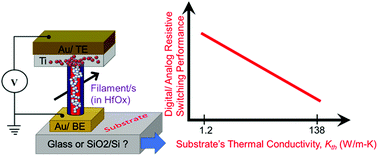Substrate dependent resistive switching in amorphous-HfOx memristors: an experimental and computational investigation†
Abstract
While two-terminal HfOx (x < 2) memristor devices have been studied for ion transport and current evolution, there have been limited reports on the effect of the long-range thermal environment on their performance. In this work, amorphous-HfOx based memristor devices on two different substrates, microscopic glass (∼1 mm) and thin SiO2 (280 nm)/Si, with different thermal conductivities in the range from 1.2 to 138 W m−1 K−1 were fabricated. Devices on glass substrates exhibit lower reset voltage, wider memory window and, in turn, a higher performance window. In addition, the devices on glass show better endurance than the devices on the SiO2/Si substrate. These devices also show non-volatile multi-level resistances at relatively low operating voltages which is critical for neuromorphic computing applications. A multiphysics COMSOL computational model is presented that describes the transport of heat, ions and electrons in these structures. The combined experimental and COMSOL simulation results indicate that the long-range thermal environment can have a significant impact on the operation of HfOx-based memristors and that substrates with low thermal conductivity can enhance switching performance.



 Please wait while we load your content...
Please wait while we load your content...